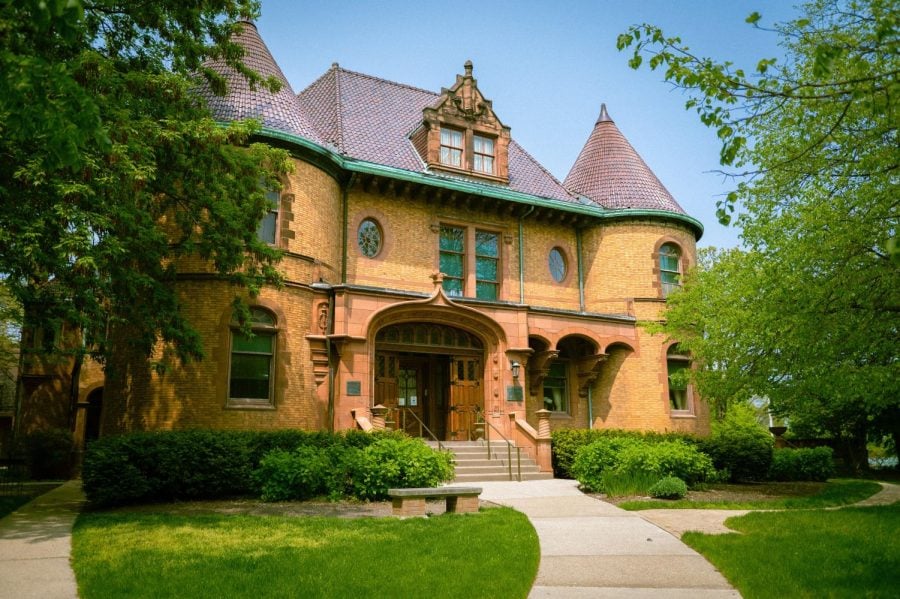Evanston History Center preserves archives, accolades of the city’s past
Kimberly Espinosa/Daily Senior Staffer
The Dawes House at 225 Greenwood St. Charles. Dawes purchased the property in 1909.
May 24, 2023
Charles Gates Dawes wore many hats during his life: U.S. vice president, Nobel Peace Prize winner, lawyer, philanthropist and musician, for starters. But one title might stand out to Evanston residents: neighbor.
Dawes and his wife purchased a property nestled among Victorian and Tudor-style homes on 225 Greenwood St., now known as The Dawes House, in 1909. Today, it’s the site of Evanston’s 160-year-long history.
After 33 years of living in the house and collecting hundreds of artworks and furnishings, Dawes decided to share his accolades with the community, arranging for neighboring Northwestern to inherit the home.
Nearly two decades later, the Evanston Historical Society, founded in 1898, took over the property from the University and adopted a new name for it: the Evanston History Center.
“This place has been around almost 125 years, and it’s a national historical landmark,” said Executive Director Eden Juron Pearlman. “To preserve the house and the history as we do is the biggest responsibility anyone can have.”
Pearlman began her work with the center in 1996 as a collections curator, overseeing the archives of the Dawes House. She became executive director in 2005.
Her primary responsibility is to oversee the center’s mission “to collect, preserve, share and interpret the rich history of the City of Evanston,” according to its website. This work happens in various ways, including tours, educational programs, exhibits, research and events, she said.
“It’s a different job every day,” Pearlman said. “You arrive in the morning and think, ‘Oh, I’ll get this done today.’ But then somebody shows up at your door and tells you they’ve discovered this amazing artifact that just has to go in your archive. There is no standard day.”
The center has seven employees, three of whom work full-time. The nonprofit organization sources its income from leading walking tours of the Dawes House and Evanston, hosting fundraiser events like the Mother’s Day House Walk, applying for historical grants, running a lecture series and renting out the facility for external events like weddings.
While 19th-century paintings, couches and kitchenware in near-perfect condition greet visitors on the main floor of the house, the facility boasts much more above and below the lobby.
Climbing the home’s grand staircase, visitors can experience two or three rotating exhibits at a time, assembled in the old bedrooms of the Dawes family. Mannequins dressed in original 19th-century ball gowns designed in Evanston are just some of the offerings to explore.
“In the early days, the thing people collected was clothing. We have the second-largest costume collection in the state. When we have an exhibit like this, we get to show it off,” Pearlman said.
Two floors below lies the hidden gem of the center: the archival collection. An endless sea of files containing information about churches, schools, businesses, buildings and family history line the shelves, which border computers containing an online database of historical documents and data.
The research room is open to the public Tuesday, Wednesday, Thursday and Saturday from 1-4 p.m. Conducting in-person research there costs $10 per visit.
One Evanston resident taking advantage of the facility is Gwyn Jennings, who first used the center’s database in 2005 to research the historical reason behind her street’s construction.
Jennings also used the center after discovering artifacts while her street was under construction. She said she noticed dozens of glass bottles in an underground pit visible to the public in the rubble on her street. Her 12-year-old son collected several of them, which the center credited to him and displayed as part of its junior collection program.
“When I was looking for important information, (the center) was certainly a handy resource,” Jennings said. “I’m not sure many Evanston residents realize the research component is even available.”
Jennings said some neighbors are biased against visiting the center because Dawes’ lavish lifestyle does not represent or reflect Evanston.
Pearlman, however, noted the center’s evolution since she began her career. She said it looks different from when its exclusive goal was to preserve the history of Evanston’s wealthy white men.
One example of this evolution is the museum’s name change in 1960 from a “society” to a “center.” Pearlman said a society implies exclusivity, while a center implies inclusivity. Now, the center highlights the contributions of historically marginalized groups to Evanston’s success in addition to Dawes’ accolades.
“Today, it’s a far more interesting place, a far more welcoming place, a far more inclusive place. We have a long way to go, but I think we’re really trending in the right direction. We want to be everyone’s historical center,” Pearlman said.
Email: [email protected]
Twitter: @charlottehrlich
Related Stories:
— Evanston History Center hosts virtual tour of Evanston’s eight African American Heritage sites
— Evanston History Center time capsule creates space for remembrance, hope and living history
— As history unfolds, Evanston History Center creates a record












